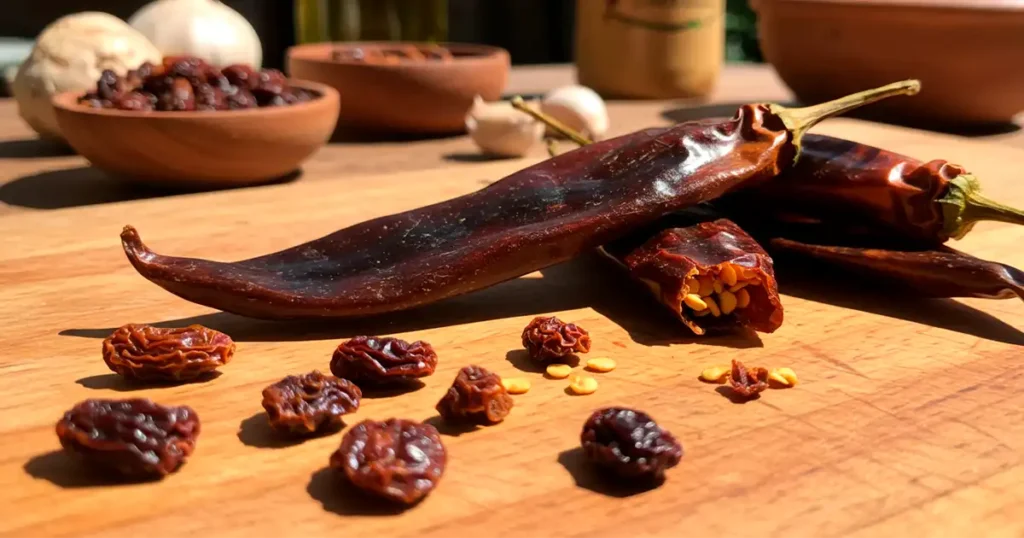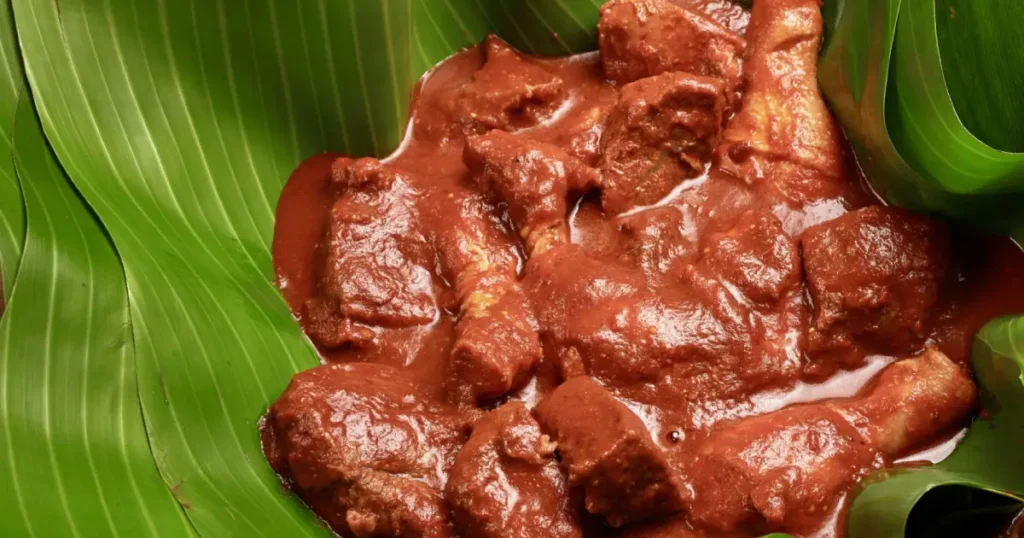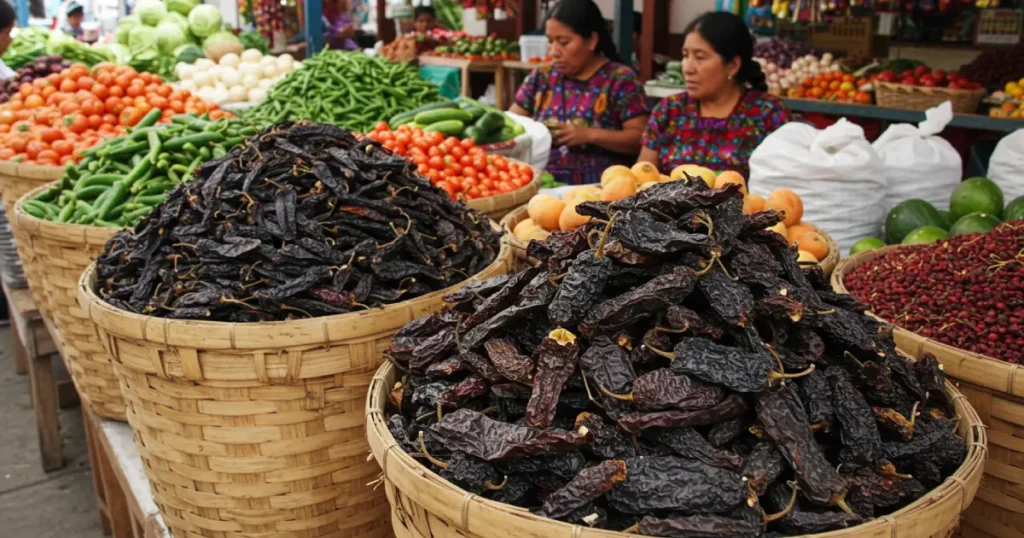Chile Pasa: Guatemala's Rich & Fruity Dried Chili for Mole & Salsas

Guatemalan cuisine is a captivating mosaic of ancient Mayan traditions and vibrant Spanish influences, a culinary landscape painted with a diverse array of chili peppers. Each chili contributes its unique personality, from fiery heat to subtle smokiness.

Among these, the Chile Pasa stands as a distinguished and deeply cherished variety, revered for its complex, fruity flavor, its ability to impart a rich, dark hue, and its indispensable role in some of Guatemala's most iconic dishes, particularly its intricate recados (sauces/pastes) and the beloved mole. Journey with us as we uncover the story of Chile Pasa, a dried chili that embodies the profound and nuanced flavors of Guatemala.
What is Chile Pasa? Unveiling a Culinary Gem
The Chile Pasa, often referred to as "Pasilla" or "Chile Negro" (black chili) in other regions, particularly Mexico, is the dried form of the fresh Chilaca pepper. The name "Pasa" itself translates to "raisin," a fitting description given its dark, wrinkled appearance and its subtly sweet, fruity notes reminiscent of dried fruit. In Guatemala, while "Pasilla" might be understood, "Chile Pasa" is the more common local term for this specific chili.
These chilies are typically long and slender, ranging from 6 to 10 inches (15 to 25 cm) in length and about 1 to 1.5 inches (2.5 to 4 cm) in width. When fresh, the Chilaca pepper is a dark green, maturing to a deep brown. Upon drying, it transforms into the Chile Pasa, characterized by its blackish-brown, wrinkled skin and a flexible, leathery texture. It's this transformation that concentrates its unique flavors, making it a prized ingredient for adding depth, complexity, and a beautiful dark color to Guatemalan gastronomy.
Flavor Profile and Scoville Scale: A Symphony of Mild Heat and Richness
The Chile Pasa is celebrated for its intricate flavor profile rather than intense pungency. Its taste is a delightful combination of:
- Fruity Undertones: Notes of dried fruit, particularly raisins and prunes, are prominent, lending a mild sweetness.
- Earthy Complexity: Underlying the fruitiness are deep, earthy tones that add a savory richness.
- Subtle Cocoa and Coffee Hints: Many palates detect subtle hints of unsweetened cocoa or coffee, contributing to its dark, mole-like character.
- Licorice or Anise Notes: A slight whisper of licorice or anise can sometimes be perceived, adding to its unique aromatic profile.
- Very Mild Smokiness: While not overtly smoked like a Chipotle or Cobanero, the drying process can impart a very delicate, almost imperceptible smokiness that enhances its overall depth.
When it comes to heat, the Chile Pasa is considered mild to medium-mild. On the Scoville Heat Unit (SHU) scale, it typically ranges from 250 to 3,999 SHU. This makes it significantly milder than a jalapeño (which averages around 5,000 SHU). This low level of heat allows its complex flavors to shine through, making it an excellent choice for sauces and dishes where depth of flavor and rich color are paramount, without overwhelming the palate with spiciness. It's often used in combination with other chilies to create a layered and balanced flavor profile.
The Cornerstone of Guatemalan Cuisine: Chile Pasa's Culinary Roles
Chile Pasa is far from a minor player in the Guatemalan kitchen; it is a foundational ingredient, lending its distinctive character to a host of traditional and beloved dishes.
Recados and Moles: The Soul of Guatemalan Flavor
"Recados" are the heart and soul of many Guatemalan stews and main courses. These are not simple sauces but complex, aromatic pastes created from a blend of toasted and ground chilies, seeds, vegetables, and spices. Chile Pasa, with its dark color and rich flavor, is a star performer in many of these:

- Pepián: Guatemala's renowned national dish, Pepián, often features Chile Pasa alongside Chile Guaque. In Pepián Negro (Black Pepián), the Chile Pasa's dark hue and rich, slightly bitter notes are particularly emphasized, contributing to the sauce's characteristic color and profound flavor. It harmonizes with roasted tomatoes, tomatillos, pumpkin seeds (pepitoria), sesame seeds, and other spices to create a truly unforgettable sauce.
- Mole de Plátano (Plantain Mole): This iconic Guatemalan dessert or sweet-savory dish is perhaps one ofthe most famous applications of Chile Pasa. The chili's fruity and chocolatey notes are a perfect complement to the sweet fried plantains. The mole sauce for this dish typically includes Chile Pasa, chocolate, tomatoes, sesame seeds, pumpkin seeds, and spices like cinnamon. The Chile Pasa provides not only color but a crucial flavor counterpoint to the sweetness.
- Suban-ik: This celebratory Mayan stew, often cooked in mashan leaves, utilizes a blend of chilies to create its rich recado. Chile Pasa is frequently included for its color and flavor complexity, mingling with other chilies, meats, and vegetables.
- Other Recados Rojos and Negros (Red and Black Sauces): Chile Pasa is a versatile ingredient in various other red and black recados used to flavor chicken, pork, and beef dishes, providing depth and a signature dark tone.
Salsas and Soups: Adding Depth and Nuance
Beyond recados, Chile Pasa enriches other Guatemalan culinary creations:
- Salsas Oscuras (Dark Salsas): While Chile Guaque might be more common for everyday table salsas due to its brighter red, Chile Pasa is used to create richer, darker, and more complex cooked salsas, often served with roasted meats or as a component in more elaborate dishes.
- Sopa de Tortilla (Tortilla Soup): In some variations of this classic soup, especially those aiming for a deeper, more complex broth, Chile Pasa can be used. Crispy fried strips of Chile Pasa are also a traditional garnish for tortilla soup, adding a textural contrast and a burst of its unique flavor.
- Enchilada Sauces: While Guatemalan enchiladas are quite different from their Mexican counterparts (often served as a tostada topped with vegetables and curtido), the sauces used can sometimes incorporate Chile Pasa for a richer flavor.
Preparing Chile Pasa: Awakening its Latent Flavors

To fully harness the exquisite flavors of dried Chile Pasa, a few essential preparation steps are customarily followed in Guatemalan kitchens:
- Wiping Clean: The dried chilies are first gently wiped with a clean, damp cloth to remove any residual dust or impurities.
- Stemming and Seeding (and De-veining): The tough stem is always removed. For most Guatemalan preparations, especially those aiming for smooth sauces like mole, the chilies are slit open lengthwise, and the seeds and veins are carefully scraped out and discarded. The seeds can introduce bitterness, and the veins contain a higher concentration of capsaicin, which, while low in Chile Pasa, is often removed to ensure the purest flavor and smoothest texture.
- Toasting (Tatemado): This is a crucial step that awakens and intensifies the Chile Pasa's complex flavors. The cleaned, de-stemmed, and de-seeded chilies are lightly toasted on a dry comal (a traditional clay or cast-iron griddle) or a skillet over medium heat. This process takes only a minute or two per side. The chilies will become fragrant and slightly more pliable. It is vital not to burn them, as this will impart an acrid, bitter taste to the final dish. Properly toasted chilies release their aromatic oils and develop deeper, more nuanced fruity and earthy notes.
- Rehydrating: After toasting, the chilies are rehydrated to soften them, making them easier to blend into sauces. This is typically done by soaking them in hot (not boiling) water for 15 to 30 minutes, or until they are fully softened and plump. The rehydrating liquid, which now contains some of the chili's essence and color, is often reserved and used as part of the liquid base for the recado or mole.
- Blending: Once rehydrated, the softened Chile Pasa peppers are ready to be blended with other quintessential Guatemalan ingredients—such as tomatoes (often roasted), garlic, onions, pepitoria (pumpkin seeds), sesame seeds, and various spices—to create the rich, dark, and flavorful sauces that define so many traditional dishes.
Chile Pasa in the Company of Other Guatemalan Chilies
Understanding Chile Pasa often involves comparing it to its counterparts in the Guatemalan chili trinity:
- Chile Guaque (Guajillo): As discussed previously, Chile Guaque is milder and has a brighter, tangier, and more overtly fruity flavor profile, imparting a rich red color. Chile Pasa is darker, with deeper, sweeter, and more raisiny notes, contributing a brownish-black hue. They are often used together, as in Pepián, to create a more complex flavor and color profile.
- Chile Cobanero: This is a much smaller, significantly hotter chili from Alta Verapaz, known for its intense, bright heat and distinctive smoky flavor derived from its traditional drying process over wood fires. Its role is primarily to add picante and a smoky depth, whereas Chile Pasa focuses on rich, dark, fruity complexity with minimal heat.
- Chile Ancho: While more prominent in Mexican cuisine, the Ancho (dried Poblano pepper) shares some similarities with Chile Pasa in its mildness and fruity notes. However, Anchos tend to be broader, sweeter, and can have a slightly more pronounced tobacco note. Guatemalan cuisine distinctively favors the Pasa, Guaque, and Cobanero for its traditional recados.
The unique contribution of Chile Pasa is its ability to lend an unparalleled depth of flavor, a characteristic dark richness, and a subtle sweetness that is hard to replicate with other chilies.
Sourcing and Storing Your Chile Pasa

Within Guatemala, Chile Pasa is a common sight in local "mercados" (markets), where vendors display them in large baskets, and they are also available packaged in supermarkets. You'll find them sold whole and dried.
For those residing outside Guatemala, Chile Pasa (often labeled as Pasilla or Chile Negro) can be found in well-stocked Latin American grocery stores, international sections of larger supermarkets, specialty spice shops, or through online retailers that cater to global cuisines. When selecting Chile Pasa, look for peppers that are somewhat pliable and soft to the touch, not overly brittle or cracked, which can be a sign of old age. They should have a deep, dark, almost black-brown color and a fragrant, slightly fruity aroma.
Proper storage is key to maintaining their flavor and longevity. Keep dried Chile Pasa in an airtight container, away from direct sunlight, heat, and moisture. A cool, dark pantry is ideal. Stored correctly, they can last for many months, even up to a year, though their flavor intensity might slowly diminish over very extended periods.
The Cultural Weave of Chile Pasa
The Chile Pasa is more than just a seasoning in Guatemala; it is a thread in the nation's rich cultural and culinary tapestry. Its presence in iconic dishes like Mole de Plátano and Pepián ties it directly to celebrations, family gatherings, and the cherished traditions of Guatemalan hospitality. The knowledge of how to select, prepare, and blend Chile Pasa into complex recados is often a skill passed down through generations, a testament to the enduring legacy of Mayan and mestizo culinary arts.
It represents a connection to the land and the agricultural heritage of Guatemala. The transformation of the fresh Chilaca into the richly flavored Pasa through drying is a traditional preservation technique that speaks to a resourceful and flavor-conscious food culture.
Embracing the Dark Elegance of Chile Pasa
The Chile Pasa, with its evocative name hinting at raisins, offers a journey into the deeper, more nuanced flavors of Guatemalan cuisine. Its mild heat allows its complex notes of dried fruit, earth, and subtle cocoa to take center stage, creating sauces and moles that are both comforting and sophisticated. It is a chili that doesn't shout but rather sings a rich, dark, and soulful melody in the symphony of Guatemalan flavors.
Whether you are a culinary explorer venturing into the tastes of Central America or a seasoned aficionado of global chilies, discovering the magic of Chile Pasa is an invitation to appreciate the subtlety and depth that a well-chosen chili can bring to the table. It is, without a doubt, an indispensable contributor to the soulful and delicious heritage of Guatemala Food.

Leave a Reply